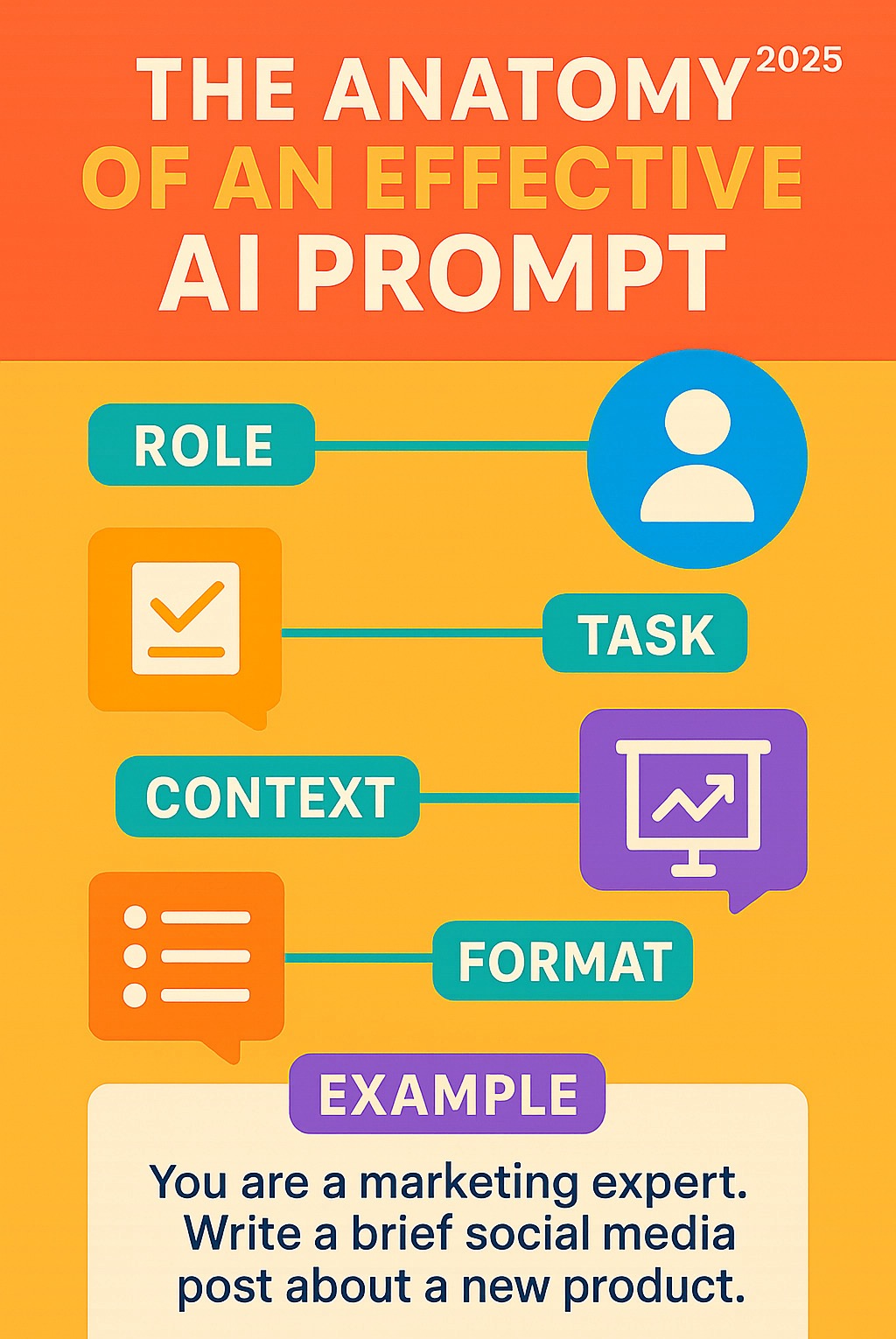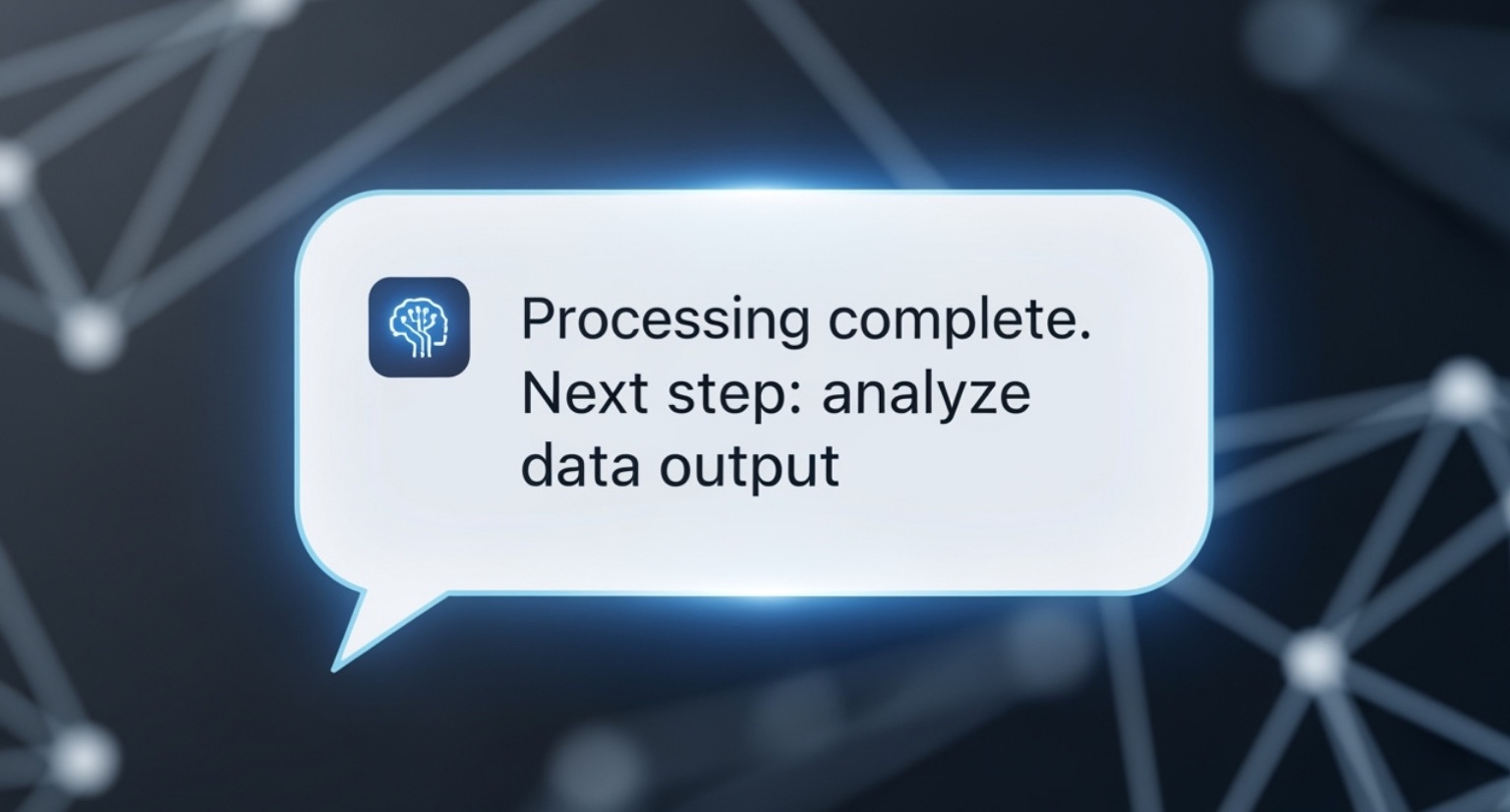Mastering the Art of Prompt Engineering: Crafting Effective AI Prompts
Why Effective AI Prompts Matter More Than You Think.

Effective AI prompts are the key to opening up AI's true potential. Here's what makes them work:
Core Elements of Effective AI Prompts:
- Be Specific - Define your topic, audience, format, and desired length clearly.
- Provide Context - Give background information and set the scene for better responses.
- Structure Output - Specify format (bullets, tables, word count) to get organized results.
- Use Constraints - Include "do" and "don't" instructions to guide AI responses.
- Iterate & Refine - Never accept the first answer; build on responses for better results.
Ever feel like you're getting vague, irrelevant, or off-target responses from AI? You're not alone. The quality of AI output depends entirely on the quality of your prompt. As one Reddit power user puts it: "AI isn't magic. It's just really good at following instructions."
The problem isn't the AI—it's how we communicate with it. Most people treat AI like a search engine, but it works more like programming with words. Give it clear, structured instructions, and it becomes incredibly powerful. Give it vague requests, and you get generic, unhelpful responses.
This shift from simple questions to strategic instructions changes everything. Instead of asking, "Write about marketing," successful users write detailed prompts that specify audience, format, tone, and constraints. The difference in results is night and day. The good news? Writing effective prompts is a learnable skill.

What is an AI Prompt and Why is Quality Crucial?
An AI prompt is your input—a question, command, or set of instructions—that directs the AI's response. The quality is crucial because of a simple principle: "garbage in, garbage out." Vague or ambiguous prompts lead to vague or irrelevant outputs.
Large language models (LLMs) are powerful tools that excel at following instructions, not reading minds. Clear, specific, and well-structured prompts guide the AI to generate accurate, insightful, and relevant content. Without quality prompts, you risk getting plausible-sounding but inaccurate information (known as "hallucinations") or content that simply misses the mark.
As the University of Michigan's guide to prompt literacy emphasizes, learning to communicate effectively with AI is a foundational skill that turns it from a frustrating black box into a powerful, collaborative partner.
The Shift from Simple Questions to Strategic Instructions
We're used to search engines, where we type keywords to find existing information. Generative AI is different; it doesn't just search, it creates. This is why prompt quality matters so much. You're not just looking for information; you're instructing a complex model to generate something new.
This is the "art and science of prompting." It's an art that requires creativity and intuition, and a science because repeatable principles lead to better outcomes. The nuances of how you phrase a prompt significantly impact the AI's interpretation and the final output.
The Building Blocks: Crafting Effective AI Prompts
Think of effective AI prompts as blueprints for your AI assistant. To get great AI output, you need clear, well-structured instructions. The difference between a frustrated user and a power user comes down to mastering these core principles.

Principle 1: Be Specific and Clear
Vague prompts create vague responses. If you get a generic answer, your prompt was likely too broad. Specificity is the foundation of all successful AI interactions.
Consider the difference:
- Vague: "Write about climate change."
- Specific: "Write a 500-word article for an environmental science blog explaining how climate change affects Arctic wildlife. Focus on polar bears and include recent data from 2020 onward."
The second prompt gives the AI a clear target by defining the topic, audience, length, and goal. This precision helps you avoid ambiguity and get the output you actually need.
Principle 2: Provide Rich Context
Context is like giving your AI assistant the full backstory. It transforms simple requests into detailed briefs. This includes setting the scene with background information, assigning a persona ("act as a marketing expert"), and providing situational details.
For example, instead of "a recipe," try "a recipe using chicken, pasta, and tomatoes that a busy parent can make in 30 minutes." The context makes the result genuinely useful.
Another powerful technique is few-shot prompting, where you provide examples of your desired writing style or format.
Principle 3: Define the Output Structure and Format
Tell the AI how to present the information. Without format instructions, you might get a wall of text when you needed a list. Be explicit about the structure you want.

Ask for a markdown table, bullet points, a Q&A format, or a specific word count. For example, "Create a comparison table with columns for Feature, Product A, and Product B" gets you exactly what you need. AI models excel at creating structured output like JSON and markdown when instructed clearly.
Principle 4: Use "Do" and "Don't" Instructions
A game-changing technique is to tell the AI what NOT to do. These inclusion and exclusion criteria act as guardrails, keeping the AI focused.
Negative constraints are powerful for guiding AI responses. Instead of hoping the AI avoids certain pitfalls, tell it directly.
- "Do include statistics from reputable sources."
- "Don't use technical jargon."
- "Do keep a conversational tone."
- "Don't exceed 300 words."
These boundaries refine the output by giving the AI clear parameters. For instance, "Don't use technical jargon" can make a complex response accessible to your intended audience.
Level Up Your Skills: Advanced Prompting Frameworks and Techniques
Once you've got the basics down, it's time to master AI. Advanced techniques help you tackle complex projects, get consistent results, and turn AI into a true creative partner.
From Good to Great: How to Write Effective AI Prompts Using Structured Frameworks
Frameworks are like checklists for complex tasks, ensuring you cover all your bases. They provide a systematic way to guide AI reasoning and break down complex requests into manageable parts.
One powerful framework is Persona, Task, Context, Format (PTCF):
- Persona: Tell the AI who to be ("You are a seasoned financial analyst").
- Task: Define the exact goal ("Identify the top three risk factors in this report").
- Context: Provide relevant background ("Focus on the tech sector").
- Format: Specify the output structure ("Provide a 5-point summary").
Another popular approach is Role, Task, Audience, Format, Tone (RTAFT), which adds explicit instructions for audience and tone. This is great for content creation.
The Power of Role-Playing: "Act As If..."
Assigning a specific persona to the AI changes how it thinks about a problem. It transforms the AI's vocabulary, perspective, and approach.

"Write a social media post" is generic. But "Act as a senior marketing specialist with expertise in viral content. Draft a compelling social media post..." yields a strategic response. This is also great for simulating scenarios, like asking a "personal trainer" for workout ideas for someone who dislikes exercise. It helps you see problems from multiple angles.
You can find hundreds of proven "Act as if..." prompts and start remixing them on our platform, where the community has tested and refined effective personas for various use cases.
The Art of Iteration: Refining Prompts for Perfection
Never accept the first answer. Think of the AI's initial response as a rough draft. The real magic happens when you treat AI as a creative partner and provide feedback.
Build on previous responses with follow-up prompts. Instead of starting over, try: "That's a great start—now expand on the second point and add a real-world example." Give specific feedback, telling the AI what worked and what didn't. If you spot a mistake, correct it directly: "Actually, that statistic is outdated. Can you update it with more recent data?"
This collaborative approach makes your interactions with AI far more productive. Our platform makes this iteration process seamless with built-in version control, so you can experiment freely without losing your progress.
Beyond the Basics: Advanced Tips for Effective AI Prompts
- The "Lazy Essay" trick: For complex writing, guide the AI through multiple steps: assign a role, provide detailed instructions and sources, and outline the structure. The AI does the heavy lifting while you maintain control.
- Politeness: Research shows that polite prompts ("Could you please...") often generate longer, more thoughtful responses.
- Use delimiters: For complex prompts with multiple parts, use separators like triple quotes """ or hashtags ### to avoid confusing the AI.
- Encourage analysis: Use phrases like "Think through this step-by-step" or "Consider the pros and cons" to prompt deeper reasoning before the AI generates its final answer.
Practical Applications, Pitfalls, and Quick Wins
Let's explore how to apply these principles, steer common pitfalls, and use some quick wins for immediate results.
Choosing the Right Prompt for the Job
Different tasks require different prompts. Matching the prompt type to your goal is key to getting the right kind of output.
| Prompt Type | Description | Example |
|---|---|---|
| Creative | Generates original, imaginative content. | "Write a story about a futuristic garden." |
| Summarization | Condenses long texts into key points. | "Summarize this article in three bullet points." |
| Instructional | Provides step-by-step guidance. | "Give me instructions on how to bake a chocolate cake." |
| Reasoning | Analyzes information and draws conclusions. | "Explain the economic implications of climate change." |
| Translation | Converts text between languages or simplifies jargon. | "Explain blockchain in simple terms." |
Use creative prompts for brainstorming, summarization for overviews, instructional for processes, reasoning for analysis, and translation for simplifying complex topics.
Navigating AI Limitations: Hallucinations and Bias
AI isn't perfect. It can suffer from hallucinations (generating plausible but false information) and reflect biases from its training data. The New York Times on AI hallucinations highlights this persistent challenge.
Effective prompting helps mitigate these risks. By providing clear context and specific instructions, you give the AI less room to invent facts. However, critical review is essential. Always fact-check important information.
To improve accuracy:
- Ask the AI to "cite your sources."
- Use the iterative refinement process to correct errors and guide the AI toward factual responses.
Quick Wins: Short-Hand Prompts That Work Like Magic
Sometimes, a single word can transform your output. These shortcuts boost productivity without complex frameworks:
- "Rephrase": Turns clunky writing into natural, conversational text.
- "Humanize": Adds warmth and personality to robotic-sounding content.
- "TL;DR": Instantly summarizes long articles or documents.
- "Critique": Turns the AI into an editor, providing feedback on your writing.
- "ELI5" (Explain Like I'm 5): Breaks down complex topics into simple terms.
- "Brainstorm": Open up creative ideas for titles, product names, or marketing angles.
These simple commands guide the AI toward the specific type of output you need, saving you time and effort.
Frequently Asked Questions about Effective AI Prompts
How long should an AI prompt be?
The ideal length depends on the task's complexity. Simple requests, like "What's the capital of France?", work well with short, direct prompts. However, complex tasks benefit from longer, more detailed prompts that provide rich context, specific instructions, and a clear format.
The key is to be comprehensive but concise. Provide all essential information, but avoid unnecessary fluff that could confuse the AI. Every word in your prompt should serve a purpose.
Can I use the same prompt across different AI models?
While the core principles of effective prompting apply everywhere, each AI model has its own strengths and nuances. An identical prompt can produce surprisingly different results across different systems because they are trained on unique datasets.
The best approach is to test and tweak your prompts when switching between AI platforms. What works perfectly on one might need adjustment on another. Flexibility and experimentation are key, which is why a system for tracking and versioning prompts is so valuable.
Is "prompt engineering" a long-term career?
Knowing how to craft effective prompts is a valuable skill today. In the long term, the role may evolve. As AI gets better at understanding our intent, the need for hyper-specific prompt crafting might decrease.
However, the core skill of problem definition—clearly identifying and articulating complex challenges for an AI to solve—will remain crucial. As mentioned in this Harvard Business Review article, strategic thinking and problem formulation will become even more valuable. The ability to communicate clearly with AI, in whatever form it takes, will always be a vital skill.
Conclusion: Transform Your Ideas into Reality with Better Prompts
You now have the tools to open up AI's true potential. The foundation is simple: be specific, provide context, define the output structure, and use clear constraints. Mastering these principles, along with advanced techniques like frameworks, role-playing, and iteration, will lift your results.
While AI has limitations like hallucinations and bias, you know how to mitigate them through critical review and refinement. AI is a powerful tool, but your judgment is irreplaceable. Quick wins like "humanize" or "ELI5" can also instantly improve your outputs.
Prompting is more than a technical skill; it's a form of communication. The better you can express your intent, the more effectively you can turn your ideas into reality. Better prompts lead to better outcomes, whether you're analyzing data, writing copy, or brainstorming solutions.
This is where the future gets exciting. Prompting doesn't have to be a solo skill. At Potions, we believe the best prompts come from collaboration. Our community-powered platform lets you find, remix, and evolve hundreds of proven prompts.
Every prompt on our platform is versioned and given a stable URL, so you can experiment freely and build upon the collective wisdom of other AI enthusiasts. It's like having a team of prompt experts working alongside you.
So, here's your call to action: Don't just ask; instruct. Don't just prompt; engineer. Put what you've learned into practice. Start with simple improvements and gradually incorporate advanced techniques.
Ready to take the next step? Start exploring and remixing proven AI prompts today! Join a community that's changing prompt engineering from a solo struggle into a collaborative craft. With better prompts, there's no limit to what you can create.